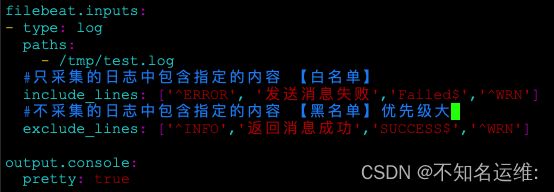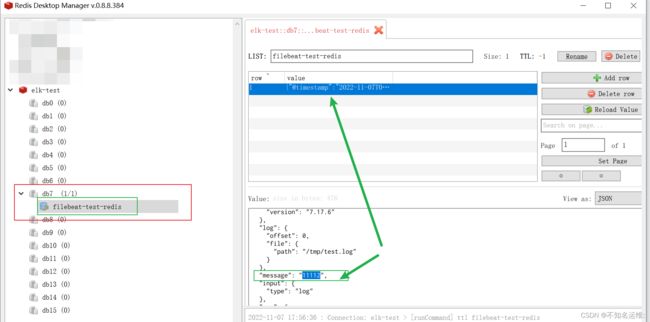Filebeat日志收集案例;
文章目录
- 1、部署filebeat
- 2、修改filebeat的配置⽂件
- 3、input的log类型(修改filebeat收集的日志到终端案例)
- 4、input的通配符案例
- 5、input的通用字段案例
- 6、将数据写入ES案例
- 7、自定义索引名称案例
- 8、根据不同的标签/字段,写入不同的索引案例
- 9、自定义分片和副本数量案例
- 10、基于log类型收集nginx原生日志
- 11、基于log类型收集nginx的json日志
- 12、基于modules类型采集nginx日志文件
- 13、基于modules类型采集tomcat日志文件
- 14、基于log类型收集tomcat的原生日志
- 15、基于log类型收集tomcat的json日志
- 16、基于log类型多行匹配案例-收集tomcat的错误日志
- 17、filebeat 日志过滤案例
- 18、filestream类型解析json日志案例
- 19、filestream类型多行匹配案例--收集tomcat的错误日志
- 20、filebeat日志聚合到本地案例
- 21、filebeat日志聚合到ES案例
- 22、将filebeat收集的数据写入redis案例
1、部署filebeat
[root@localhost ~]# mkdir -p /hqtbj/hqtwww/
[root@localhost ~]# wget -cP /hqtbj/hqtwww/ https://artifacts.elastic.co/downloads/beats/filebeat/filebeat-7.17.6-linux-x86_64.tar.gz
[root@localhost ~]# cd /hqtbj/hqtwww/
[root@localhost hqtwww]# tar -zxf filebeat-7.17.6-linux-x86_64.tar.gz
[root@localhost hqtwww]# mv filebeat-7.17.6-linux-x86_64 filebeat_workspace
2、修改filebeat的配置⽂件
(1)编写测试的配置文件
[root@localhost ~]# mkdir -p /hqtbj/hqtwww/filebeat_workspace/config/
[root@localhost ~]# cat >> /hqtbj/hqtwww/filebeat_workspace/config/01-stdin-to-console.yml << EOF
#指定输入的类型
filebeat.inputs:
#指定输入的类型喂stdin,表示标准输入
- type: stdin
#指定输出的类型
output.console:
#打印漂亮的输出格式
pretty: true
EOF
(2)运行filebeat实例
[root@localhost ~]# cd /hqtbj/hqtwww/filebeat_workspace/
[root@localhost filebeat_workspace]# ./filebeat -e -c config/01-stdin-to-console.yml
运行后会阻塞终端,在终端内直接输入任意内容,会以json格式来返回输入的内容到终端,即为测试成功;
3、input的log类型(修改filebeat收集的日志到终端案例)
filebeat默认是按行来读取的
[root@localhost ~]# cat >> /hqtbj/hqtwww/filebeat_workspace/config/02-log-to-console.yml << EOF
filebeat.inputs:
- type: log
paths:
- /tmp/test.log
output.console:
pretty: true
EOF
运行成功后观察终端输出,在/tmp/test.log里输入任意内容,将会以json格式来返回输入的内容到终端,即为测试成功;
4、input的通配符案例
[root@localhost ~]# cat >> /hqtbj/hqtwww/filebeat_workspace/config/03-log-to-console.yml << EOF
filebeat.inputs:
- type: log
paths:
- /tmp/test.log
- /tmp/*.txt
- type: log
paths:
- /tmp/test/*/*.log
output.console:
pretty: true
EOF
5、input的通用字段案例
[root@localhost ~]# cat >> /hqtbj/hqtwww/filebeat_workspace/config/04-log-to-console.yml << EOF
filebeat.inputs:
- type: log
#是否启用当前的输入类型,默认值为true
enabled: true
#指定数据路径
paths:
- /tmp/test.log
- /tmp/*.txt
#给当前的输入类型打上标签
tags: ["oldboyedu-linux80","容器运维","DBA运维","SRE运维工程师"]
#自定义字段
fields:
school: "北京昌平区沙河镇"
class: "linux-80"
- type: log
enabled: true
paths:
- /tmp/test/*/*.log
tags: ["oldboyedu-python","云原生开发"]
fields:
name: "oldboy"
hobby: "linux,抖音"
#将自定义字段的key-value放到顶级字段,
#默认值为false,会将数据放在一个叫fields的字段下面;
fields_under_root: true
output.console:
pretty: true
EOF
6、将数据写入ES案例
[root@localhost ~]# cat >> /hqtbj/hqtwww/filebeat_workspace/config/05-log-to-es.yml << EOF
filebeat.inputs:
- type: log
enabled: true
paths:
- /tmp/test.log
- /tmp/*.txt
tags: ["oldboyedu-linux80","容器运维","DBA运维","SRE运维工程师"]
fields:
school: "北京昌平区沙河镇"
class: "linux-80"
- type: log
enabled: true
paths:
- /tmp/test/*/*.log
tags: ["oldboyedu-python","云原生开发"]
fields:
name: "oldboy"
hobby: "linux,抖音"
fields_under_root: true
output.elasticsearch:
#ES地址
hosts: ["http://192.168.1.1:9200","http://192.168.1.2:9200","http://192.168.1.3:9200"]
EOF
7、自定义索引名称案例
[root@localhost ~]# cat >> /hqtbj/hqtwww/filebeat_workspace/config/06-log-to-es.yml << EOF
filebeat.inputs:
- type: log
enabled: true
paths:
- /tmp/test.log
- /tmp/*.txt
tags: ["oldboyedu-linux80","容器运维","DBA运维","SRE运维工程师"]
fields:
school: "北京昌平区沙河镇"
class: "linux-80"
- type: log
enabled: true
paths:
- /tmp/test/*/*.log
tags: ["oldboyedu-python","云原生开发"]
fields:
name: "oldboy"
hobby: "linux,抖音"
fields_under_root: true
output.elasticsearch:
enabled: true
hosts: ["http://192.168.1.1:9200","http://192.168.1.2:9200","http://192.168.1.3:9200"]
index: "oldboyedu-linux-elk-%{+yyyy.MM.dd}"
#禁用索引生命周期管理,如果开启的话则会忽略我们自定义的索引;
setup.ilm.enabled: false
#设置索引模板的名称
setup.template.name: "oldboyedu-linux"
#设置索引模板的匹配模式
setup.template.pattern: "oldboyedu-linux-*"
EOF
8、根据不同的标签/字段,写入不同的索引案例
[root@localhost ~]# cat >> /hqtbj/hqtwww/filebeat_workspace/config/07-log-to-es.yml << EOF
filebeat.inputs:
- type: log
enabled: true
paths:
- /tmp/test.log
- /tmp/*.txt
tags: ["oldboyedu-linux80","容器运维","DBA运维","SRE运维工程师"]
fields:
school: "北京昌平区沙河镇"
class: "linux-80"
- type: log
enabled: true
paths:
- /tmp/test/*/*.log
tags: ["oldboyedu-python","云原生开发"]
fields:
name: "oldboy"
hobby: "linux,抖音"
fields_under_root: true
output.elasticsearch:
enabled: true
hosts: ["http://192.168.1.1:9200","http://192.168.1.2:9200","http://192.168.1.3:9200"]
indices:
- index: "oldboyedu-linux-elk-%{+yyyy.MM.dd}"
#匹配指定字段包含的内容
when.contains:
tags: "容器运维"
- index: "oldboyedu-linux-python-%{+yyyy.MM.dd}"
when.contains:
tags: "云原生开发"
setup.ilm.enabled: false
setup.template.name: "oldboyedu-linux"
setup.template.pattern: "oldboyedu-linux-*"
EOF
9、自定义分片和副本数量案例
[root@localhost ~]# cat >> /hqtbj/hqtwww/filebeat_workspace/config/08-log-to-es.yml << EOF
filebeat.inputs:
- type: log
enabled: true
paths:
- /tmp/test.log
- /tmp/*.txt
tags: ["oldboyedu-linux80","容器运维","DBA运维","SRE运维工程师"]
fields:
school: "北京昌平区沙河镇"
class: "linux-80"
- type: log
enabled: true
paths:
- /tmp/test/*/*.log
tags: ["oldboyedu-python","云原生开发"]
fields:
name: "oldboy"
hobby: "linux,抖音"
fields_under_root: true
output.elasticsearch:
enabled: true
hosts: ["http://192.168.1.1:9200","http://192.168.1.2:9200","http://192.168.1.3:9200"]
#index: "oldboyedu-linux-elk-%{+yyyy.MM.dd}"
indices:
- index: "oldboyedu-linux-elk-%{+yyyy.MM.dd}"
when.contains:
tags: "容器运维"
- index: "oldboyedu-linux-python-%{+yyyy.MM.dd}"
when.contains:
tags: "云原生开发"
setup.ilm.enabled: false
setup.template.name: "oldboyedu-linux"
setup.template.pattern: "oldboyedu-linux-*"
#覆盖已有的索引模版,如果为true则会直接覆盖现有的模版,为false则为不覆盖;
setup.template.overwrite: false
#配置索引模版
setup.template.settings:
#设置分片数量
index.number_of_shards: 3
#设置副本数量,要求小于集群节点的数量,否则会出现副本分片无法分配的情况(集群状态呈黄色)
index.number_of_replicas: 2
EOF
10、基于log类型收集nginx原生日志
[root@localhost ~]# cat >> /hqtbj/hqtwww/filebeat_workspace/config/09-nginx-to-es.yml << EOF
filebeat.inputs:
- type: log
enabled: true
paths:
- /var/log/nginx/access.log*
tags: ["nginx-access"]
output.elasticsearch:
enabled: true
hosts: ["http://192.168.1.1:9200","http://192.168.1.2:9200","http://192.168.1.3:9200"]
index: "oldboyedu-linux-nginx-%{+yyyy.MM.dd}"
#禁用索引生命周期管理,如果开启的话则会忽略我们自定义的索引
setup.ilm.enabled: false
#设置索引模板的名称
setup.template.name: "oldboyedu-linux"
#设置索引模板的匹配模式
setup.template.pattern: "oldboyedu-linux-*"
#覆盖已有的索引模版
setup.template.overwrite: false
#配置索引模版
setup.template.settings:
#设置分片数量
index.number_of_shards: 3
#设置副本数量,要求小于集群节点的数量
index.number_of_replicas: 2
EOF
11、基于log类型收集nginx的json日志
(1)修改nginx原生日志输出格式为json格式
[root@localhost ~]# vim /etc/nginx/nginx.conf
...
log_format oldboyedu_nginx_json '{"@timestamp":"$time_iso8601",'
'"host":"$server_addr",'
'"clientip":"$remote_addr",'
'"SendBytes":$body_bytes_sent,'
'"responsetime":$request_time,'
'"upstreamtime":"$upstream_response_time",'
'"upstreamhost":"$upstream_addr",'
'"http_host":"$host",'
'"uri":"$uri",'
'"domain":"$host",'
'"xff":"$http_x_forwarded_for",'
'"referer":"$http_referer",'
'"tcp_xff":"$proxy_protocol_addr",'
'"http_user_agent":"$http_user_agent",'
'"status":"$status"}';
access_log /var/log/nginx/access.log oldboyedu_nginx_json;
(2)检查nginx并启动
[root@localhost ~]# nginx -t
nginx: the configuration file /etc/nginx/nginx.conf syntax is ok
nginx: configuration file /etc/nginx/nginx.conf test is successful
[root@localhost ~]# nginx -s reload
(3)定义filebeat配置文件
[root@localhost ~]# cat >> /hqtbj/hqtwww/filebeat_workspace/config/10-nginx-to-es.yml << EOF
filebeat.inputs:
- type: log
enabled: true
paths:
- /var/log/nginx/access.log*
tags: ["nginx-access-json"]
#以JSON格式解析message内容,拆分字段;
json.keys_under_root: true
output.elasticsearch:
enabled: true
hosts: ["http://192.168.1.1:9200","http://192.168.1.2:9200","http://192.168.1.3:9200"]
index: "oldboyedu-linux-nginx-access-%{+yyyy.MM.dd}"
#禁用索引生命周期管理,如果开启的话则会忽略我们自定义的索引
setup.ilm.enabled: false
#设置索引模板的名称
setup.template.name: "oldboyedu-linux"
#设置索引模板的匹配模式
setup.template.pattern: "oldboyedu-linux-*"
#覆盖已有的索引模版
setup.template.overwrite: false
#配置索引模版
setup.template.settings:
#设置分片数量
index.number_of_shards: 3
#设置副本数量,要求小于集群节点的数量
index.number_of_replicas: 2
EOF
12、基于modules类型采集nginx日志文件
(1)定义filebeat配置文件
[root@localhost ~]# cat >> /hqtbj/hqtwww/filebeat_workspace/filebeat.yml << EOF
filebeat.config.modules:
#指定模块的配置文件路径;${path.config}就是//hqtbj/hqtwww/filebeat_workspace
path: ${path.config}/modules.d/*.yml
#开启热加载功能
reload.enabled: false
output.elasticsearch:
enabled: true
hosts: ["http://192.168.1.1:9200","http://192.168.1.2:9200","http://192.168.1.3:9200"]
index: "oldboyedu-linux-nginx-access-%{+yyyy.MM.dd}"
#禁用索引生命周期管理,如果开启的话则会忽略我们自定义的索引
setup.ilm.enabled: false
#设置索引模板的名称
setup.template.name: "oldboyedu-linux"
#设置索引模板的匹配模式
setup.template.pattern: "oldboyedu-linux-*"
#覆盖已有的索引模版
setup.template.overwrite: false
#配置索引模版
setup.template.settings:
#设置分片数量
index.number_of_shards: 3
#设置副本数量,要求小于集群节点的数量
index.number_of_replicas: 2
EOF
(2)查看并启用nginx模块
[root@localhost ~]# cd /hqtbj/hqtwww/filebeat_workspace/
#查看现有的模块
[root@localhost filebeat_workspace]# ./filebeat modules list
#开启nginx模块
[root@localhost filebeat_workspace]# ./filebeat modules enable nginx
#关闭打开的模块使用disable
#例如:
[root@localhost filebeat_workspace]# ./filebeat modules disable nginx
(3)编辑/hqtbj/hqtwww/filebeat_workspace/modules.d/nginx.yml(nginx模块的配置文件,用于收集nginx日志)
[root@localhost filebeat_workspace]# egrep -v "^*#|^$" /hqtbj/hqtwww/filebeat_workspace/modules.d/nginx.yml
- module: nginx
access:
enabled: true
var.paths: ["/var/log/nginx/access.log"]
error:
enabled: false
var.paths: ["/var/log/nginx/error.log"]
ingress_controller:
enabled: false
13、基于modules类型采集tomcat日志文件
(1)部署tomcat
略...
(2)定义filebeat配置文件
[root@localhost ~]# cat >> /hqtbj/hqtwww/filebeat_workspace/filebeat.yml << EOF
filebeat.config.modules:
#指定模块的配置文件路径;${path.config}就是//hqtbj/hqtwww/filebeat_workspace
path: ${path.config}/modules.d/*.yml
#开启热加载功能
reload.enabled: false
output.elasticsearch:
enabled: true
hosts: ["http://192.168.1.1:9200","http://192.168.1.2:9200","http://192.168.1.3:9200"]
index: "oldboyedu-linux-tomcat-access-%{+yyyy.MM.dd}"
#禁用索引生命周期管理,如果开启的话则会忽略我们自定义的索引
setup.ilm.enabled: false
#设置索引模板的名称
setup.template.name: "oldboyedu-linux"
#设置索引模板的匹配模式
setup.template.pattern: "oldboyedu-linux-*"
#覆盖已有的索引模版
setup.template.overwrite: false
#配置索引模版
setup.template.settings:
#设置分片数量
index.number_of_shards: 3
#设置副本数量,要求小于集群节点的数量
index.number_of_replicas: 2
EOF
(3)查看并启用tomcat模块
[root@localhost ~]# cd /hqtbj/hqtwww/filebeat_workspace/
#查看现有的模块
[root@localhost filebeat_workspace]# ./filebeat modules list
#开启nginx模块
[root@localhost filebeat_workspace]# ./filebeat modules enable tomcat
#关闭打开的模块使用disable
#例如:
[root@localhost filebeat_workspace]# ./filebeat modules disable tomcat
(4)编辑/hqtbj/hqtwww/filebeat_workspace/modules.d/tomcat.yml(nginx模块的配置文件,用于收集nginx日志)
[root@localhost filebeat_workspace]# egrep -v "^*#|^$" /hqtbj/hqtwww/filebeat_workspace/modules.d/tomcat.yml
- module: tomcat
log:
enabled: true
# 指定输⼊的类型是⽂件(file),默认是监听udp端⼝(不会向es传输日志)
var.input: file
#tomcat访问日志的位置
var.paths:
- /hqtbj/hqtwww/apache-tomcat-8.5.9/logs/localhost_access_log*.txt
14、基于log类型收集tomcat的原生日志
[root@localhost ~]# cat >> /hqtbj/hqtwww/filebeat_workspace/config/13-tomcat-to-es.yml << EOF
filebeat.inputs:
- type: log
enabled: true
#tomcat的访问日志位置
paths:
- /hqtbj/hqtwww/apache-tomcat-8.5.9/logs/*.txt
tags: ["tomcat-access-json"]
output.elasticsearch:
enabled: true
hosts: ["http://192.168.1.1:9200","http://192.168.1.2:9200","http://192.168.1.3:9200"]
index: "oldboyedu-linux-tomcat-access-%{+yyyy.MM.dd}"
#禁用索引生命周期管理,如果开启的话则会忽略我们自定义的索引
setup.ilm.enabled: false
#设置索引模板的名称
setup.template.name: "oldboyedu-linux"
#设置索引模板的匹配模式
setup.template.pattern: "oldboyedu-linux-*"
#覆盖已有的索引模版
setup.template.overwrite: false
#配置索引模版
setup.template.settings:
#设置分片数量
index.number_of_shards: 3
#设置副本数量,要求小于集群节点的数量
index.number_of_replicas: 2
15、基于log类型收集tomcat的json日志
(1)自定义tomcat的日志格式
[root@localhost ~]# vim /hqtbj/hqtwww/apache-tomcat-8.5.9/conf/server.xml
...
#大约在148-164之间,主要修改下吗的pattern字段:
<Host name="localhost" appBase="webapps"
unpackWARs="true" autoDeploy="true">
<!-- SingleSignOn valve, share authentication between web applications
Documentation at: /docs/config/valve.html -->
<!--
<Valve className="org.apache.catalina.authenticator.SingleSignOn" />
-->
<!-- Access log processes all example.
Documentation at: /docs/config/valve.html
Note: The pattern used is equivalent to using pattern="common" -->
<Valve className="org.apache.catalina.valves.AccessLogValve" directory="logs"
prefix="localhost_access_log" suffix=".txt"
pattern="{"clientip":"%h","ClientUser":"%l","authenticated":"%u","AccessTime":"%t","request":"%r","status":"%s","SendBytes":"%b","Query?string":"%q","partner":"%{Referer}i","http_user_agent":"%{User-Agent}i"}" />
</Host>
(2)修改filebeat的配置文件
[root@localhost ~]# cat >> /hqtbj/hqtwww/filebeat_workspace/13-tomcat-to-es.yml << EOF
filebeat.inputs:
- type: log
enabled: true
paths:
- /hqtbj/hqtwww/apache-tomcat-8.5.9/logs/*.txt
tags: ["tomcat-access-json"]
#以JSON格式解析message内容,拆分字段;
json.keys_under_root: true
output.elasticsearch:
enabled: true
hosts: ["http://192.168.1.1:9200","http://192.168.1.2:9200","http://192.168.1.3:9200"]
index: "oldboyedu-linux-tomcat-access-%{+yyyy.MM.dd}"
#禁用索引生命周期管理,如果开启的话则会忽略我们自定义的索引
setup.ilm.enabled: false
#设置索引模板的名称
setup.template.name: "oldboyedu-linux"
#设置索引模板的匹配模式
setup.template.pattern: "oldboyedu-linux-*"
#覆盖已有的索引模版
setup.template.overwrite: false
#配置索引模版
setup.template.settings:
#设置分片数量
index.number_of_shards: 3
#设置副本数量,要求小于集群节点的数量
index.number_of_replicas: 2
EOF
16、基于log类型多行匹配案例-收集tomcat的错误日志
[root@localhost ~]# cat >> /hqtbj/hqtwww/filebeat_workspace/14-tomcat-to-es.yml << EOF
filebeat.inputs:
- type: log
enabled: true
paths:
- /hqtbj/hqtwww/apache-tomcat-8.5.9/logs/*.out
tags: ["tomcat-error-json"]
#指定多行匹配的类型,可选值为pattern(常用,只要下面匹配的参数出现就换行),count(次数,用于下面匹配的参数出现多少次就换行)
multiline.type: pattern
#指定匹配的模式,这里的'^\d{2}代表的是以两个数字开头的,例如11或者12'
multiline.pattern: '^\d{2}'
#下面两个参数参考官方架构图即可;https://www.elastic.co/guide/en/beats/filebeat/7.17/multiline-examples.html
multiline.negate: true
multiline.match: after
output.elasticsearch:
enabled: true
hosts: ["http://192.168.1.1:9200","http://192.168.1.2:9200","http://192.168.1.3:9200"]
index: "oldboyedu-linux-tomcat-error-%{+yyyy.MM.dd}"
#禁用索引生命周期管理,如果开启的话则会忽略我们自定义的索引
setup.ilm.enabled: false
#设置索引模板的名称
setup.template.name: "oldboyedu-linux"
#设置索引模板的匹配模式
setup.template.pattern: "oldboyedu-linux-*"
#覆盖已有的索引模版
setup.template.overwrite: false
#配置索引模版
setup.template.settings:
#设置分片数量
index.number_of_shards: 3
#设置副本数量,要求小于集群节点的数量
index.number_of_replicas: 2
EOF
无多行匹配收集错误日志:

可以看到错误日志被当作单独的一行来展示了,非常影响排错
17、filebeat 日志过滤案例
(1)排除日志中指定的内容;类似【黑名单】的作用
[root@localhost ~]# cat >> /hqtbj/hqtwww/filebeat_workspace/15-log-to-console.yml << EOF
filebeat.inputs:
- type: log
paths:
- /tmp/test.log
#不采集的日志中包含指定的内容(例如下方指定的以"INFO"开头的数据、日志中包含"发送消息成功"的数据、日志中以"SUCCESS"结尾的数据)区分大小写
exclude_lines: ['^INFO','发送消息成功','SUCCESS$']
output.console:
pretty: true
EOF
(2)只收集日志中指定的内容;类似【白名单】的作用
[root@localhost ~]# cat >> /hqtbj/hqtwww/filebeat_workspace/16-log-to-console.yml << EOF
filebeat.inputs:
- type: log
paths:
- /tmp/test.log
#只采集的日志中包含的指定内容(例如下方指定的以"ERROR"开头的数据、日志中包含"返回消息失败"的数据、日志中以"Failed"结尾的数据)区分大小写!
include_lines: ['^ERROR', '发送消息失败','Failed$']
output.console:
pretty: true
EOF
如果include_lines和exclude_lines两种类型同时出现并指定相同的内容时,exclude_lines生效!!!
例如下方的以"WRN"开头的字段,那么将不会被采集

18、filestream类型解析json日志案例
官方警告后面log类型的input可能会被弃用,建议使用filestream类型
[root@localhost ~]# cat >> /hqtbj/hqtwww/filebeat_workspace/16-filestream-to-es.yml << EOF
filebeat.inputs:
- type: filestream
enabled: true
paths:
- /var/log/nginx/access.log
tags: ["nginx-access-json"]
#对于filestream类型而言,不能直接配置json解析,而是需要配置解析器实现
#json.keys_under_root: true
#综上所述,需要以下的写法实现
parsers:
- ndjson:
#对json字段内容进行JSON格式解析,并将key放到顶级字段
keys_under_root: true
output.elasticsearch:
enabled: true
hosts: ["http://192.168.1.1:9200","http://192.168.1.2:9200","http://192.168.1.3:9200"]
index: "oldboyedu-linux-nginx-access-%{+yyyy.MM.dd}"
#禁用索引生命周期管理,如果开启的话则会忽略我们自定义的索引
setup.ilm.enabled: false
#设置索引模板的名称
setup.template.name: "oldboyedu-linux"
#设置索引模板的匹配模式
setup.template.pattern: "oldboyedu-linux-*"
#覆盖已有的索引模版
setup.template.overwrite: false
#配置索引模版
setup.template.settings:
#设置分片数量
index.number_of_shards: 3
#设置副本数量,要求小于集群节点的数量
index.number_of_replicas: 2
EOF
19、filestream类型多行匹配案例–收集tomcat的错误日志
[root@localhost ~]# cat >> /hqtbj/hqtwww/filebeat_workspace/17-filestream_tomcat-to-es.yml << EOF
filebeat.inputs:
- type: filestream
enabled: true
paths:
- /hqtbj/hqtwww/apache-tomcat-8.5.9/logs/*.out
tags: ["tomcat-error-json"]
parsers:
- multiline:
#指定多行匹配的类型,可选值为pattern(常用,只要下面匹配的参数出现就换行),count(次数,用于下面匹配的参数出现多少次就换行)
type: pattern
#指定匹配的模式,这里的'^\d{2}代表的是以两个数字开头的,例如11或者12'
pattern: '^\d{2}'
#下面两个参数参考官方架构图即可;https://www.elastic.co/guide/en/beats/filebeat/7.17/multiline-examples.html
negate: true
match: after
output.elasticsearch:
enabled: true
hosts: ["http://192.168.1.1:9200","http://192.168.1.2:9200","http://192.168.1.3:9200"]
index: "oldboyedu-linux-tomcat-error-%{+yyyy.MM.dd}"
#禁用索引生命周期管理,如果开启的话则会忽略我们自定义的索引
setup.ilm.enabled: false
#设置索引模板的名称
setup.template.name: "oldboyedu-linux"
#设置索引模板的匹配模式
setup.template.pattern: "oldboyedu-linux-*"
#覆盖已有的索引模版
setup.template.overwrite: false
#配置索引模版
setup.template.settings:
#设置分片数量
index.number_of_shards: 3
#设置副本数量,要求小于集群节点的数量
index.number_of_replicas: 2
EOF
20、filebeat日志聚合到本地案例
日志聚合就是将多个源端的日志,聚合到同一台服务器上;
例如
客户端A 发送日志111
客户端B 发送日志222
服务器C 收集到的日志为 111和222
#基于input的tcp和udp类型将多个客户端的日志聚合到filebeat本地的文件中
[root@localhost ~]# cat >> /hqtbj/hqtwww/filebeat_workspace/18-tcp-to-file.yml << EOF
filebeat.inputs:
#tcp类型
- type: tcp
#监听的地址和端口
host: "192.168.1.4:9000"
- type: tcp
host: "192.168.1.4:9001"
#udp类型
- type: udp
host: "192.168.1.4:8000"
output.file:
#文件存放的位置
path: "/tmp/filebeat"
#指定文件名
filename: test1104.log
#指定文件的滚动大小,默认值是10MB
rotate_every_kb: 10000
#指定保存文件的个数,默认是7个,有效值是2-1024个
number_of_files: 7
#指定文件的权限,默认是0600,属主拥有可读可写的权限
permissions: 0600
EOF
21、filebeat日志聚合到ES案例
#基于input的tcp和udp类型将多个客户端的日志聚合到filebeat然后输出给ES
[root@localhost ~]# cat >> /hqtbj/hqtwww/filebeat_workspace/19-tcp-to-es.yml << EOF
filebeat.inputs:
- type: tcp
host: "192.168.1.4:9000"
tags: ["tcp-message"]
- type: tcp
host: "192.168.1.4:9001"
tags: ["tcp-message"]
- type: udp
host: "192.168.1.4:8000"
tags: ["udp-message"]
output.elasticsearch:
enabled: true
hosts: ["http://192.168.1.1:9200","http://192.168.1.2:9200","http://192.168.1.3:9200"]
#index: "oldboyedu-linux-nginx-%{+yyyy.MM.dd}"
indices:
- index: "oldboyedu-linux-tcpmessage-%{+yyyy.MM.dd}"
when.contains:
tags: "tcp-message"
- index: "oldboyedu-linux-udpmessage-%{+yyyy.MM.dd}"
when.contains:
tags: "udp-message"
#禁用索引生命周期管理,如果开启的话则会忽略我们自定义的索引
setup.ilm.enabled: false
#设置索引模板的名称
setup.template.name: "oldboyedu-linux"
#设置索引模板的匹配模式
setup.template.pattern: "oldboyedu-linux-*"
#覆盖已有的索引模版
setup.template.overwrite: false
#配置索引模版
setup.template.settings:
#设置分片数量
index.number_of_shards: 3
#设置副本数量,要求小于集群节点的数量
index.number_of_replicas: 2
EOF
22、将filebeat收集的数据写入redis案例
(1)yum方式快速部署redis
[root@localhost ~]# yum -y install redis
修改redis配置文件
[root@localhost ~]# vim /etc/redis.conf
...
#绑定监听的IP
bind 192.168.1.2
设置登录密码
requirepass 123.com.cn
#开启redis
[root@localhost ~]# systemctl start redis
其他节点连接测试redis环境
[root@localhost ~]# redis-cli -a 123.com.cn -h 192.168.1.2 -p 6379
(2)编写filebeat配置文件
[root@localhost ~]# cat >> /hqtbj/hqtwww/filebeat_workspace/20-log-to-redis.yml << EOF
filebeat.inputs:
- type: log
paths:
- /tmp/test.log
output.redis:
#写入redis的主机地址
hosts: ["192.168.1.2:6379"]
#指定redis的认证口令(登录密码)
password: "123.com.cn"
#指定的key的值,可自定义
key: "filebeat-test-redis"
#指定redis桶(数据库)编号
db: 7
#规定超时时间
timeout: 5
(3)启动filebeat并测试
[root@localhost ~]# cd /hqtbj/hqtwww/filebeat_workspace/
[root@localhost filebeat_workspace]# ./filebeat -e -c config/01-stdin-to-console.yml
测试:
在/tmp/test.log文件里添加数据11112,看redis的第7桶会不会出现"filebeat-test-redis"这个键,并且验证这个键的值是不是我们添加的11112
[root@localhost ~]# echo '11112' >> /tmp/test.log

写入redis成功,后续只要我们filebeat监听的文件里有内容输入进来,就会去redis的"filebeat-test-redis"这个键里写相应的数据;
